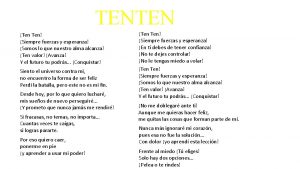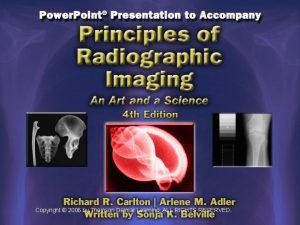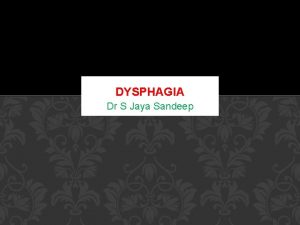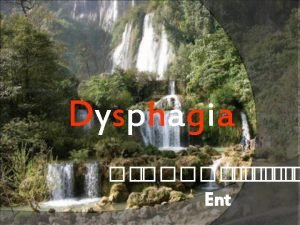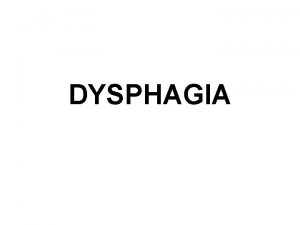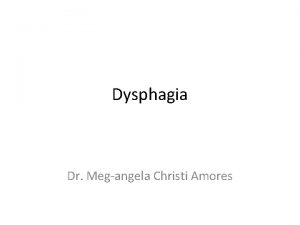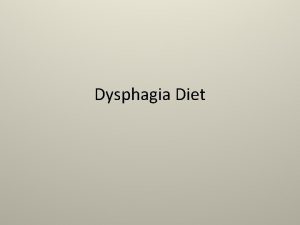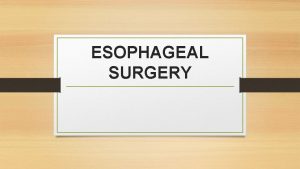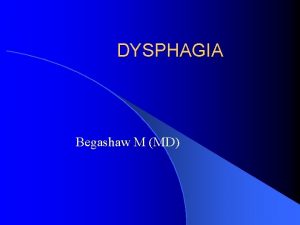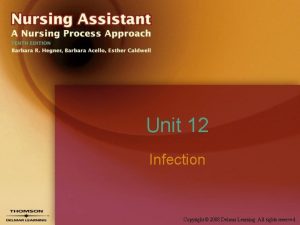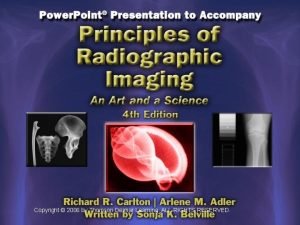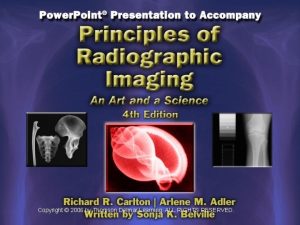Unit Ten Dysphagia Copyright 2008 Delmar All rights



































- Slides: 35

Unit Ten Dysphagia Copyright © 2008 Delmar. All rights reserved.

Chapter 40 Normal Swallow Function and Dysphagia Copyright © 2008 Delmar. All rights reserved.

Dysphagia • Difficulty swallowing that occurs when impairments affect any of the four phases of swallowing that puts a person at risk for aspiration 3 Copyright © 2008 Delmar. All rights reserved.

Dysphagia • Team approach is required: – – – SLP Dentist Dietician, PT, RT, OT, ENT Neurologist Gastroenterologist Pharmacist 4 Copyright © 2008 Delmar. All rights reserved.

Four Phases of the Normal Swallow • • Oral preparatory phase Oral phase Pharyngeal phase Esophageal phase 5 Copyright © 2008 Delmar. All rights reserved.

Oral Preparatory Phase • Thinking about food/liquid and how to get it to the mouth • Chewing the food in our mouth 6 Copyright © 2008 Delmar. All rights reserved.

Oral Phase • Begins when chewing stops • Tongue pulls the food to the back of the mouth • Takes one second 7 Copyright © 2008 Delmar. All rights reserved.

Pharyngeal Phase • Bolus contacts anterior faucial pillars and initiates the swallow response • Soft palate rises • Peristalsis moves the bolus down • Vocal folds close tightly • Esophageal sphincter pulled open 8 Copyright © 2008 Delmar. All rights reserved.

Esophageal Phase • Bolus carried to lower esophageal sphincter to enter stomach 9 Copyright © 2008 Delmar. All rights reserved.

Oral Preparatory Phase Problems • • Decreased awareness of food Difficulty holding food in mouth Pocketing food in cheeks Premature spillage of food into airway 10 Copyright © 2008 Delmar. All rights reserved.

Oral Phase Problems • Anterior spillage • Premature spillage into airway • Difficulty moving bolus back towards pharynx 11 Copyright © 2008 Delmar. All rights reserved.

Pharyngeal Phase Problems • Delayed swallow response • Impaired coordination of oral and pharyngeal structures • Weak elevation of velum • Inadequate closure of vocal folds 12 Copyright © 2008 Delmar. All rights reserved.

Esophageal Phase Problems • Upper esophageal sphincter does not open • Slow or absent esophageal peristalsis 13 Copyright © 2008 Delmar. All rights reserved.

Penetration and Aspiration • Penetration – Material enters larynx and remains above the vocal folds • Aspiration – Material goes below level of the vocal folds 14 Copyright © 2008 Delmar. All rights reserved.

Aspiration Pneumonia • Acute inflammation caused by material entering the lungs through the airway • Symptoms include spiked temperatures, myalgia, and productive cough 15 Copyright © 2008 Delmar. All rights reserved.

Chapter 41 Diagnosis of Dysphagia Copyright © 2008 Delmar. All rights reserved.

Evaluation of Adults • Review medical chart • Screen patient – Behavioral observations – Interview – Check for protective cough 17 Copyright © 2008 Delmar. All rights reserved.

Bedside Evaluation • Evaluate all speech systems • Patient drinks and eats selected consistencies of liquids and food • Monitor for signs of aspiration – Coughing, wet voice quality 18 Copyright © 2008 Delmar. All rights reserved.

Modified Barium Swallow Study • “Gold standard” of instrumental assessment • A dynamic imagining of the bolus from entering the mouth to entering the stomach 19 Copyright © 2008 Delmar. All rights reserved.

Fiberoptic Endoscopic Evaluation of Swallowing (FEES) • Provides information about pharyngeal phase • Endoscope is passed through nose into nasopharynx • Laryngopharynx can be viewed while patient eats 20 Copyright © 2008 Delmar. All rights reserved.

Ultrasound Imaging • Noninvasive imaging that uses sound waves to view the oral and laryngeal structures 21 Copyright © 2008 Delmar. All rights reserved.

Evaluating Infants and Children • • • Review medical chart Assess postural control and muscle tone Note respiratory function/endurance Evaluate oral structures Complete feeding/swallowing evaluation Instrumental assessment 22 Copyright © 2008 Delmar. All rights reserved.

Chapter 42 Treatment of Dysphagia Copyright © 2008 Delmar. All rights reserved.

Feeding Environment • Environment for eating will affect the experience with meals • SLPs can be limited in modifying many aspects of the hospital environment and its distractions 24 Copyright © 2008 Delmar. All rights reserved.

Textures and Consistencies of Food and Liquid • Foods • Regular • Dysphagia advanced • Dysphagia mechanical soft • Dysphagia pureed • • • Liquid Thin Nectar-like Honey-like Spoon-thick 25 Copyright © 2008 Delmar. All rights reserved.

Postural Techniques • Chin-tuck (down) • Head rotation • Head tilt 26 Copyright © 2008 Delmar. All rights reserved.

Oral-Motor Exercises • Can help increase muscle tone and strength 27 Copyright © 2008 Delmar. All rights reserved.

Swallow Maneuvers • Used for the pharyngeal phase: – Double or dry swallow – Effortful or hard swallow – Supraglottic swallow – Mendelsohn maneuver – Thermal/tactile stimulation 28 Copyright © 2008 Delmar. All rights reserved.

NPO – Nothing by Mouth • Patients who cannot eat orally receive nutrition through entereal feeding: – Nasogastric (NG) tube – Gastrostomy tube (G-tube) – Percutaneous endoscopic gastrostomy (PEG) tube 29 Copyright © 2008 Delmar. All rights reserved.

Goals of Treating Infants and Children • Promote adequate nutrition and hydration • Develop age-appropriate feeding skills 30 Copyright © 2008 Delmar. All rights reserved.

General Areas of Management for Children • • • Establish optimal feeding readiness Organize oral feeding Establish nonnutritive suck Establish external pacing Establish optimal position 31 Copyright © 2008 Delmar. All rights reserved.

General Areas of Management for Children • • • Develop oral stimulation program Reduce oral aversion Alter consistency, taste, temperature Develop chewing skills Choose feeding utensils 32 Copyright © 2008 Delmar. All rights reserved.

Chapter 43 Emotional and Social Effects of Dysphagia Copyright © 2008 Delmar. All rights reserved.

Emotional and Social Effects • Eating is a a social event • Diet modifications can reduce enjoyment of eating and affect quality of life 34 Copyright © 2008 Delmar. All rights reserved.

Emotional and Social Effects • • • Anxiety Depression Grief Embarrassment Sense of loss 35 Copyright © 2008 Delmar. All rights reserved.
 Copyright 2015 all rights reserved
Copyright 2015 all rights reserved Copyright © 2015 all rights reserved
Copyright © 2015 all rights reserved Dell all rights reserved copyright 2009
Dell all rights reserved copyright 2009 Copyright © 2018 all rights reserved
Copyright © 2018 all rights reserved 2008 2008
2008 2008 Copyright 2008
Copyright 2008 Copyright 2008
Copyright 2008 Copyright 2008
Copyright 2008 Copyright 2008
Copyright 2008 Copyright 2008
Copyright 2008 Copyright 2008
Copyright 2008 Copyright 2008
Copyright 2008 Twenty past two
Twenty past two Ten ten siempre fuerzas y esperanza
Ten ten siempre fuerzas y esperanza Amia 10 x 10
Amia 10 x 10 Delmar cengage learning medical terminology
Delmar cengage learning medical terminology 2009 delmar cengage learning
2009 delmar cengage learning 1/52 medical terminology
1/52 medical terminology Measuring and recording apical pulse
Measuring and recording apical pulse Delmar isotonic
Delmar isotonic Delmar tsi
Delmar tsi Delmar international (thailand)
Delmar international (thailand) Delmar thomson learning
Delmar thomson learning Chapter 6 skeletal system
Chapter 6 skeletal system 2009 delmar cengage learning
2009 delmar cengage learning 2009 delmar cengage learning
2009 delmar cengage learning Delmar larsen
Delmar larsen Delmar cengage learning instructor resources
Delmar cengage learning instructor resources Negative rights vs positive rights
Negative rights vs positive rights Riparian vs littoral
Riparian vs littoral Moral duties
Moral duties Legal rights and moral rights
Legal rights and moral rights What is negative right
What is negative right Positive vs negative rights
Positive vs negative rights Negative right
Negative right Positive rights and negative rights
Positive rights and negative rights













